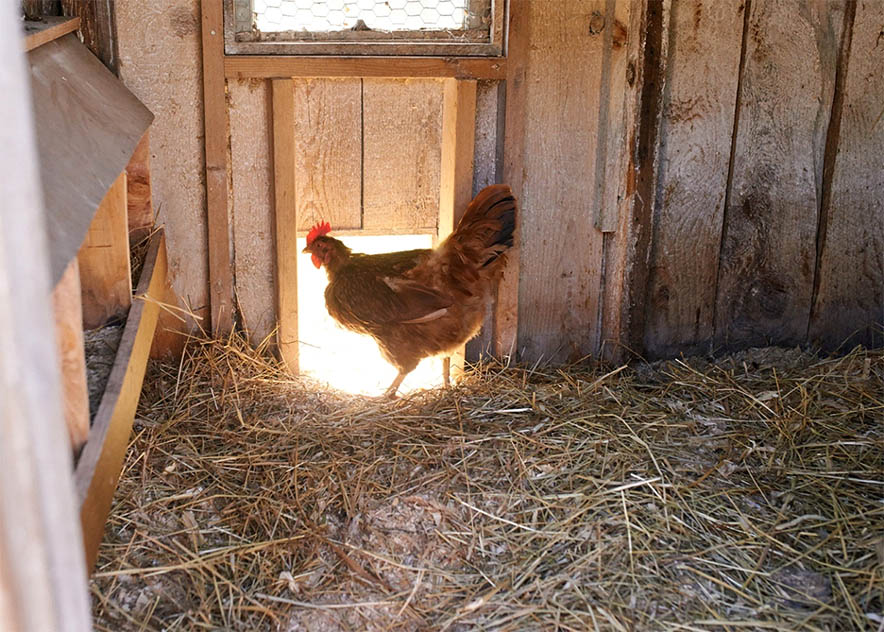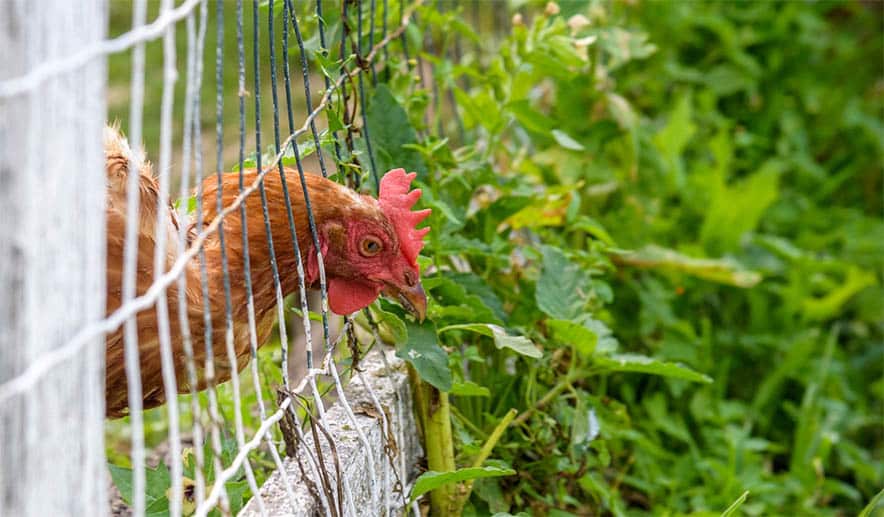Chickens are a great addition to the greenhouse for a number of reasons. They provide warmth for plants in cold winter months, offer organic pest control, and their manure can create excellent compost material for future greenhouse crops. Plants benefit from the heat and CO2 produced by the chickens, resulting in higher production.
The chickens enjoy garden scraps year-round and have a safe, warm, interesting place to sleep and forage. Warmer, brighter greenhouse conditions can keep them laying all winter. Wondering about putting chickens in your greenhouse for the winter, at night, or year-round? Here’s what you need to know.
Keeping Chickens in the Greenhouse in the Winter
A greenhouse is a great winter home for chickens, especially if you live in a very cold climate, where keeping a coop warm enough can be a challenge, and forage is often covered in snow. Furthermore, a greenhouse provides protection from predators while chickens are foraging. Foxes, coyotes, stray dogs, and other predators struggle to find food in the cold winter months and may be more likely to take risks they wouldn’t have before, like attacking your chickens while they’re foraging.
Shorter winter days usually mean reduced egg production, but you can use artificial light and warmth in your greenhouse to keep chickens laying all winter. Thermal masses like brick or flagstone pathways, stone garden borders, and a dark storage tank for water can help with heating when the sun isn’t out.
The chicken coop should have plenty of bedding to absorb the smell and provide heating as it composts. If you grow plants in the ground during the spring, fall, and summer, the manure left by chickens during the winter can be superb compost.
Till the greenhouse floor throughout winter to keep organic matter actively composting. This will reduce the time you need to wait before adding plants to the ground in the spring.
Fulltime Greenhouse Chickens
Combining a greenhouse and a chicken coop can, ideally, lower costs for chicken and greenhouse upkeep and provide mutual benefits for both. It’s also a great way to save space.
Building or buying a premade greenhouse chicken coop requires less materials to construct and maintain. We’re happy to add a chicken run or other chicken-friendly features to one of our greenhouses so they’ll have the run of the greenhouse and somewhere to enjoy the fresh air outside.
Keeping chickens in a greenhouse full-time can be a symbiotic relationship for plants and chickens, but the greenhouse must be designed around the needs of both chickens and plants.
Location and Position
To maximize sun exposure, the greenhouse windows should face south. Plant beds should be located near them. Minimize the steps from compost bin to garden beds by putting compost in the greenhouse or just outside.
Chicken nesting boxes and roosts should be on the north-facing side of the greenhouse to provide insulation against cold northern winds. Even with your best efforts, the greenhouse/chicken coop will probably have some smell, and chickens can be noisy, so keep that in mind when deciding how close to the house and outdoor living areas you want to put your chicken coop/greenhouse.
Temperature and Humidity
The temperature should not exceed 75°F, and humidity should be around 50%. Keeping the greenhouse cool and well-ventilated enough can be a challenge, especially in the summer. Heat stress can cause health problems, respiratory infections, and even death. Mild overheating can reduce egg production.
Some chicken breeds are more heat tolerant than others, including the following:
- New Hampshire Reds
- Plymouth Rocks
- Rhode Island Reds
- Orpingtons
- White Leghorns
- Easter Eggers
High humidity can also make chickens prone to disease and make it more difficult for their waste to effectively compost.
To control heat and humidity open vents and use fans to circulate the air. If you let your chickens free-range outside of the greenhouse during the day, simply leaving the doors open can be a great way to let out the heat and humidity.
If you don’t let chickens free-range outside of the greenhouse, consider attaching an outside run to allow the chickens to regulate their own temperature by going outside when they want to.
Protecting Your Plants
Use wire to protect delicate plants in the greenhouse from chickens. Keep in mind that chickens can be very dedicated to pecking through the wire, so leave enough space between the wire and the plants to keep the plants safe. Hanging plants can also be a good solution, but chickens can be surprisingly good jumpers, so make sure they’re not able to snag low-hanging vines.
Plants that chickens aren’t thrilled about eating can be left exposed so chickens can peck pests directly off of them.
Compost chicken droppings before using them as fertilizer. Chicken manure is high in nitrogen and other nutrients that are essential for plant growth. However, manure applied directly to plant roots will burn them because it is too concentrated. The manure needs to be composted first so that the nutrients are broken down and released slowly.
Manure and bedding material can be removed from the greenhouse floor, or the floor can be tilled and left to compost while the chickens are kept elsewhere. If chickens stay in the greenhouse full-time and manure isn’t removed, the buildup of manure can create an environment that impedes plant growth.
If you want to keep your chickens in your greenhouse full time, raking out the manure regularly and composting it elsewhere is probably the best option. Plants should be kept in raised beds or pots, so roots aren’t negatively affected by too much manure.
Protecting Your Chickens
A greenhouse is a great place to keep your chickens safe, but hungry predators will constantly be trying to find their way in, so you’ll need to think carefully about security. Add a good latch to vents and doors that a clever raccoon or fox won’t be able to open.
If you don’t have a floor on the greenhouse, bury fencing a few inches into the ground to prevent predators from digging under it.
Our sturdy polycarbonate panels and southern yellow pine studs and rafters can hold up to even a determined predator.
However, if you choose a greenhouse with material that may be ripped or shattered, you may want to line it with hardware cloth to keep chickens safe from predators. Motion-activated lights outside the greenhouse can deter predators and make them less likely to hassle your chickens.
The stress of being harassed by predators through the clear material of the greenhouse is detrimental to your chickens’ quality of life and egg-laying, so don’t tolerate it. Regularly check the greenhouse and the perimeter for signs of predator activity and look for any potential entry points that need to be reinforced.
Dealing with the Smell
Let’s face it, if you’re thinking about a greenhouse/chicken coop, you’re worried about the odor. Chicken coops aren’t famous for their great smell, and putting it all in an enclosed, hot, humid greenhouse sounds like a recipe for disaster. However, you may find that you don’t have trouble with smell if you follow a few simple tips:
- Keep it clean: Clean up any spilled feed, remove manure and soiled bedding, and replace bedding regularly. In the humid greenhouse environment, any uneaten organic matter is likely to mold and decay, so feed chickens only what they’ll eat.
- Ventilation: Good ventilation reduces the humidity and moisture that contributes to odors. Make sure you can open windows or doors and use a powerful fan to move air through the greenhouse.
- Absorbent bedding: Use an absorbent bedding material, such as straw or wood shavings, to absorb moisture and reduce odors. There are products available specifically designed to control odors in a chicken coop with natural enzymes or beneficial bacteria to break down organic material and eliminate odors which can be added to bedding as well.
- Plants: You’re in a greenhouse, so use plants to handle smell! Plant nitrogen-fixing groundcover wherever it will grow. Clover is a great option for the shaded greenhouse floor and is also a wonderful grazing food for chickens. Wood sorrel, also known as oxalis, is another great option. These plants growing around the edges of planting beds and lining the borders of the greenhouse are perfect for chickens to graze on and constantly work to improve the soil and consume odor-causing matter.
Give Greenhouse Chickens a Try
Keeping chickens in a greenhouse can be beneficial for plants, chickens, and you. Chickens provide warmth, pest control, and manure. The greenhouse offers a safe, warm, and dynamic foraging environment for the chickens.
You can get fresh eggs and produce from one space, all year round, while having your work in weeding, pest control, and composting reduced. However, to make it work, the greenhouse must be designed around the needs of both plants and chickens, while ensuring it remains a reasonably pleasurable place for you to work.
By following the tips here, your greenhouse/chicken coops can lower costs, save space, and make for happier chickens, plants, and people.


















